FC Nordsjælland is a club characterised by its commitment to youth development. The Danish club has gained recognition for its emphasis on nurturing young talents and providing a pathway for them to progress from the youth ranks to the first team.
The club strongly emphasises technical proficiency, tactical intelligence, and a holistic understanding of the game. Young players are encouraged to develop their skills in a conducive and challenging environment, with an emphasis on playing possession-based football. This philosophy is ingrained in the youth teams from an early age, creating a seamless transition for players as they move through the various age groups.
FC Nordsjælland has produced some immensely talented players, such as Andreas Skov Olsen, who put in some excellent performances for the Danish club and earned him a move to Serie A side Bologna before moving on to Club Brugge in Belgium.
Additionally, Chairman Tom Vernon famously founded the Right To Dream Academy in Ghana, which has been a pathway for players such as Mohammed Kudus, now of West Ham and Ernest Nuamah, currently playing in Ligue 1 for Olympique Lyonnais.
FCN are a club that always has one eye on the future, and in this scout report, we aim to highlight the players within the Nordsjælland youth system that we think are just too good for the youth team and could feature in the first team soon.
In this tactical analysis, we will use EYEBALL to identify the stand-out players, showcase their individual talents, and look into what they could bring to the FCN tactics in the near future.
Sindre Walle Egeli – U19
The first player we are going to analyse is 17-year-old winger Sindre Walle Egeli. The Norwegian primarily plays on the right side of a 4-3-3 system, which allows him to cut in onto his favoured left foot. However, he is more than capable of playing anywhere in the forward line.
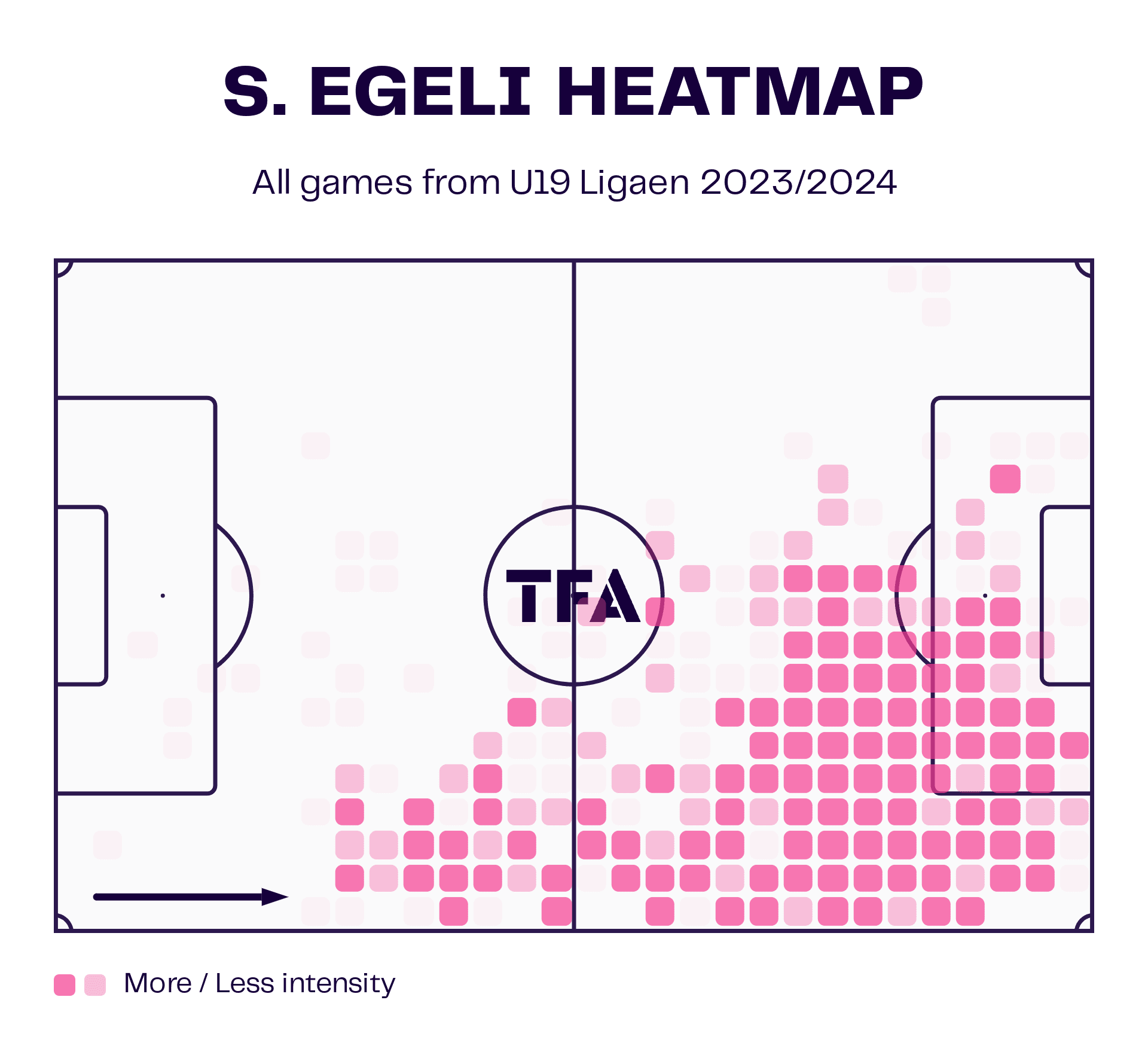
From his heatmap, we can see that Egeli drifts into central areas and operates very narrowly. This allows space for overlapping runs from the fullback and allows Egeli to link up well with the central midfielders and centre forward.
Another key benefit of this is that it facilitates the creation of goal-scoring opportunities. Egeli’s positioning allows him to be more involved in goal-scoring opportunities, whether taking shots from central positions or making runs into goal-scoring positions. As a result, he has bagged ten goals and three assists for FCN U19 during the current season. Egeli adds an element of unpredictability to the team’s attack, as he is a potent goal-scoring threat in addition to being able to provide assists for others.
Moreover, having the 17-year-old sit more narrowly contributes to midfield control. He can overload the midfield by positioning himself centrally, providing an additional passing option and numerical superiority in the middle of the pitch. This can be particularly effective in breaking down compact defensive structures, as the FCN team can dominate possession and create passing triangles in central areas, often bypassing an opposition press.
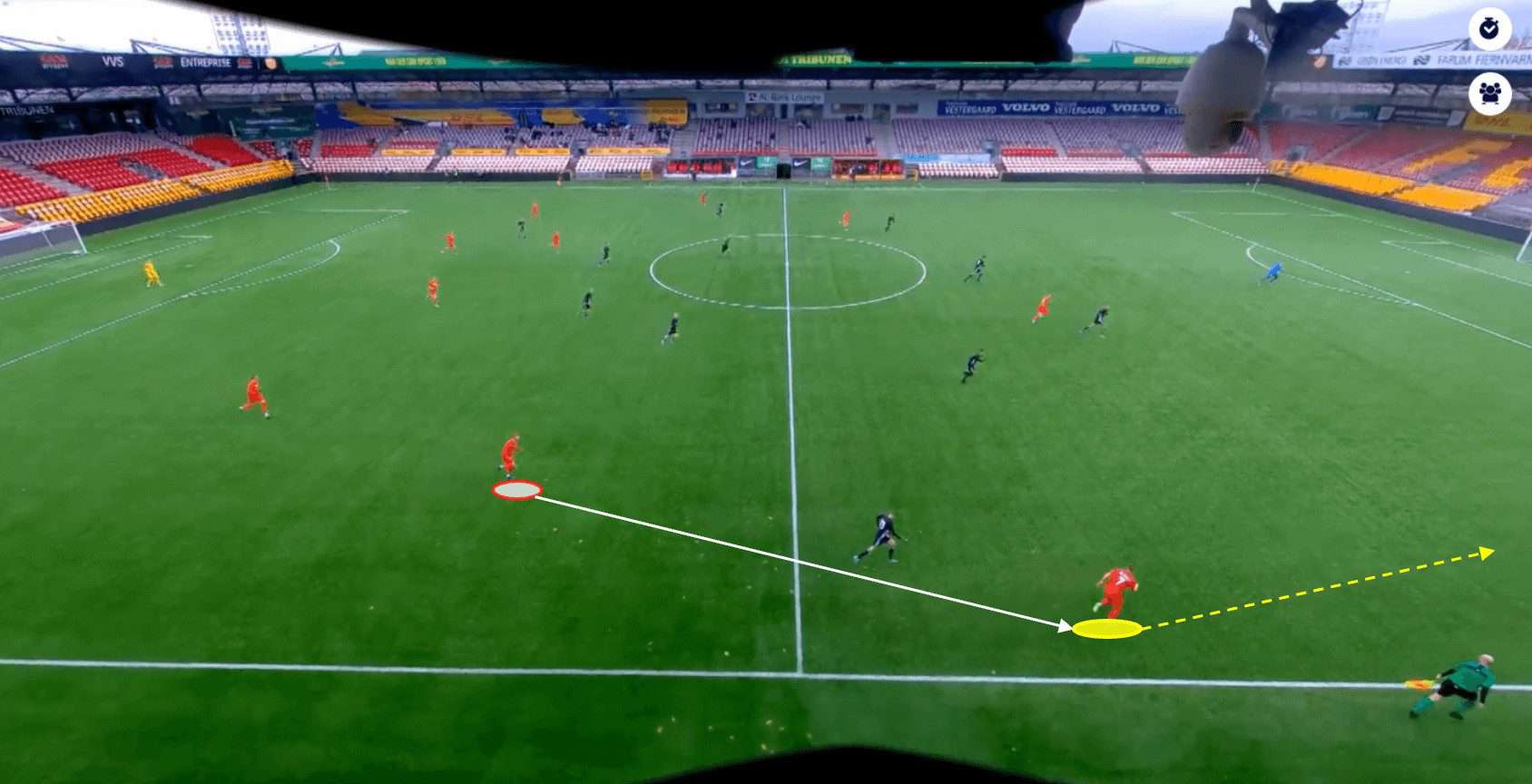
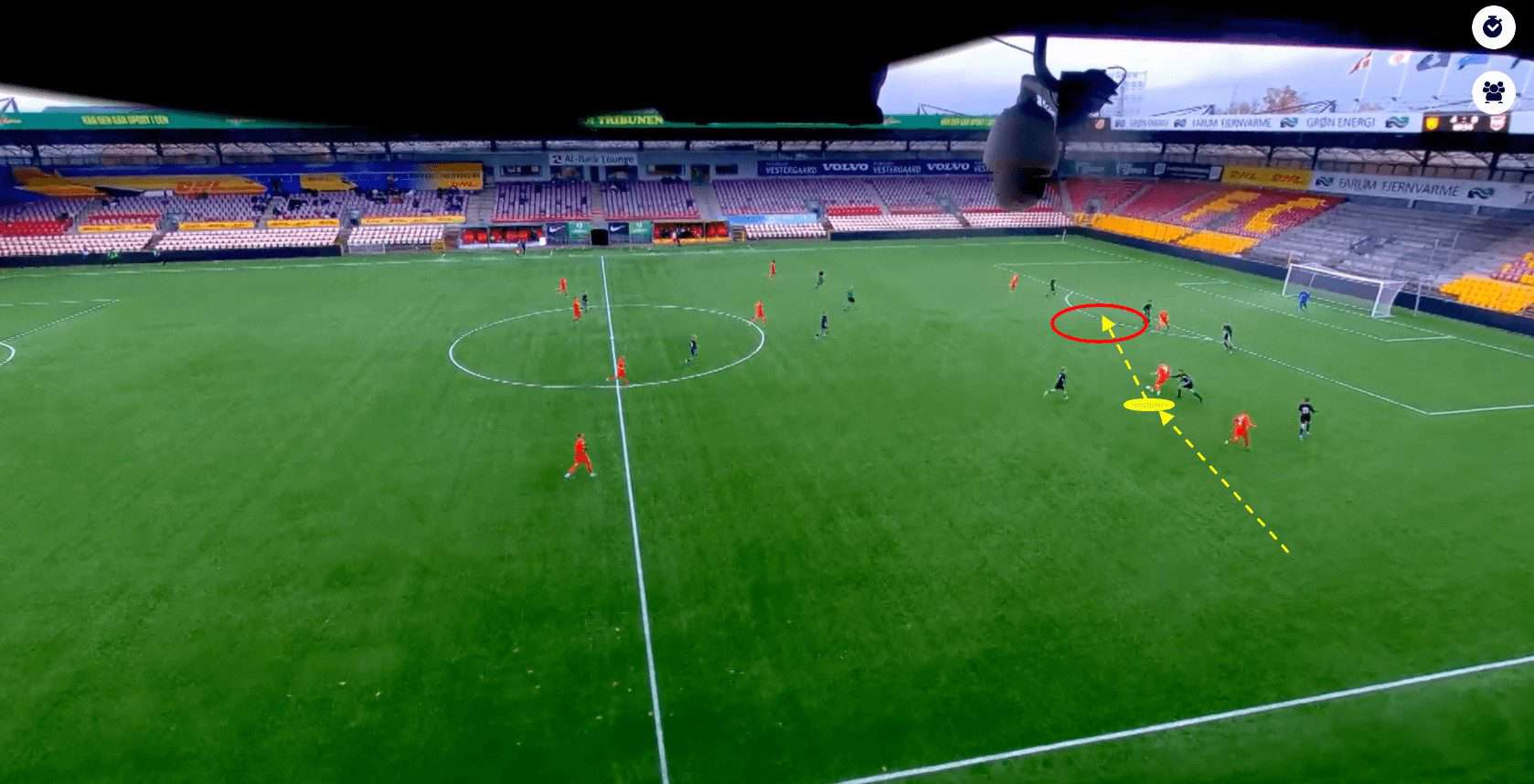
Here, we can see how Egeli likes to position himself out wide when FCN U19 are in the offensive transition. This drags the opposition out wide to try and prevent him from carrying the ball down the flank, something that often proves to be ineffective as Egeli possesses such rapid acceleration and close control the opponent simply cannot get near him.
Egeli then looks to cut inside onto his left foot, takes on his opponent and carries the ball into zone 14, where he executes a low drive on goal. The young Norwegian introduces an element of dynamism into the team’s attack. As he consistently cuts inside, he poses a constant threat to the opposition’s defence. This unpredictability makes it challenging for defenders to anticipate Egeli’s movements, creating opportunities for him to exploit defensive gaps and create goal-scoring chances, as we can see in the example above.
The FCN winger averages 4.2 take-ons per 90 and provides the team with a direct attacking threat. He can beat his opponent in one-on-one situations, which adds a dimension of creativity and flair to the FCN U19 team’s play. By successfully dribbling past opponents, Egeli often draws additional defenders over to try and close him down, which opens up spaces for teammates.
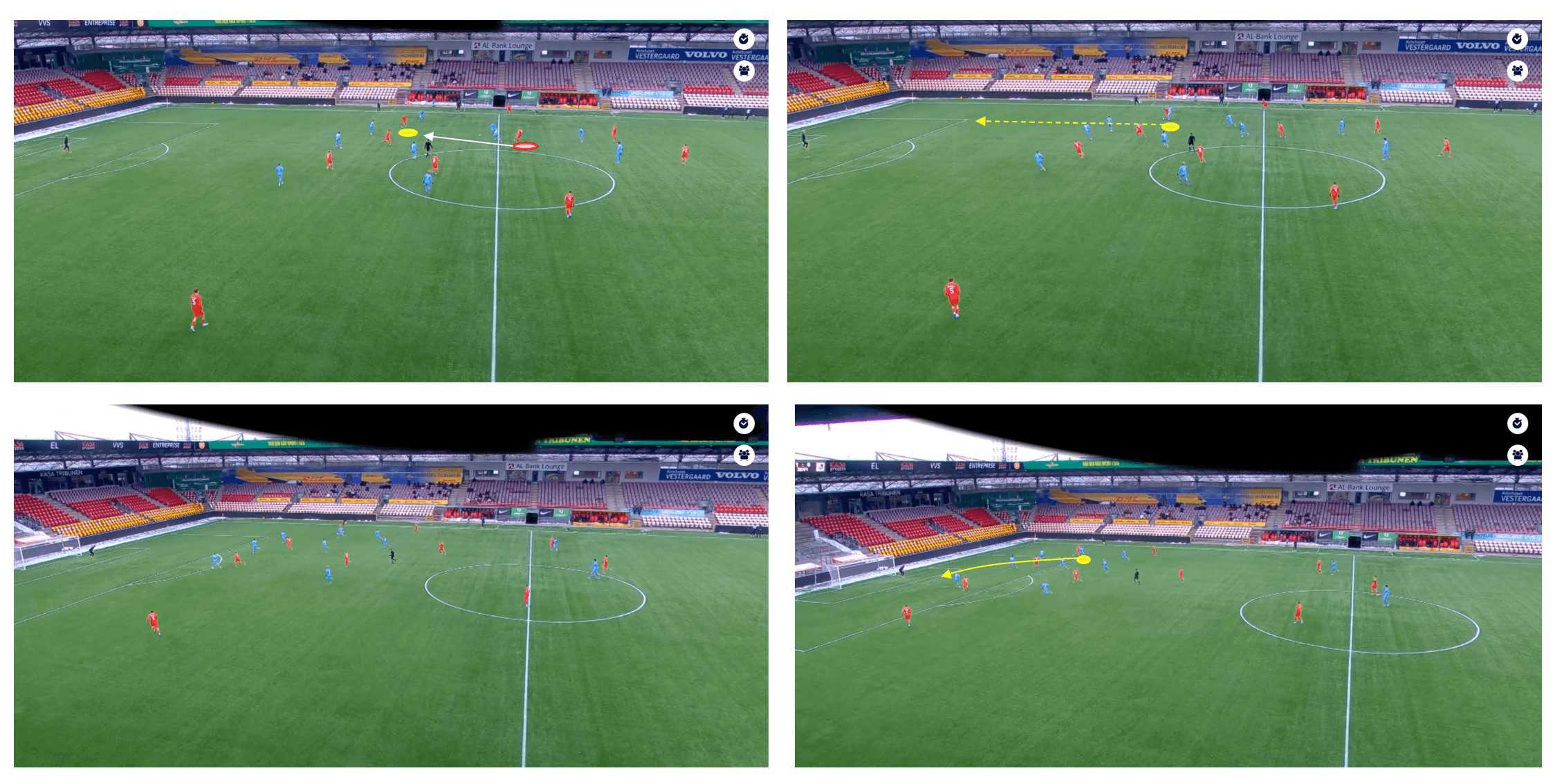
In this instance, Egeli makes a small but effective movement from the wide area into the half-space. As his teammate plays the ball into his feet, the 17-year-old, who has excellent spatial awareness, notices his opponent moving in to put him under pressure. To counter this, Egeli subtly shifts his body to pin his opponent back and prevent him from getting to the ball.
The youngster spins away from his opponent and carries the ball forward, using short bursts of acceleration to get into space to put a right-footed cross into the box. Egeli averages 3.63 crosses per 90, although only 19.4% find their intended target. An area for improvement in the future is to add an extra dimension to his game.
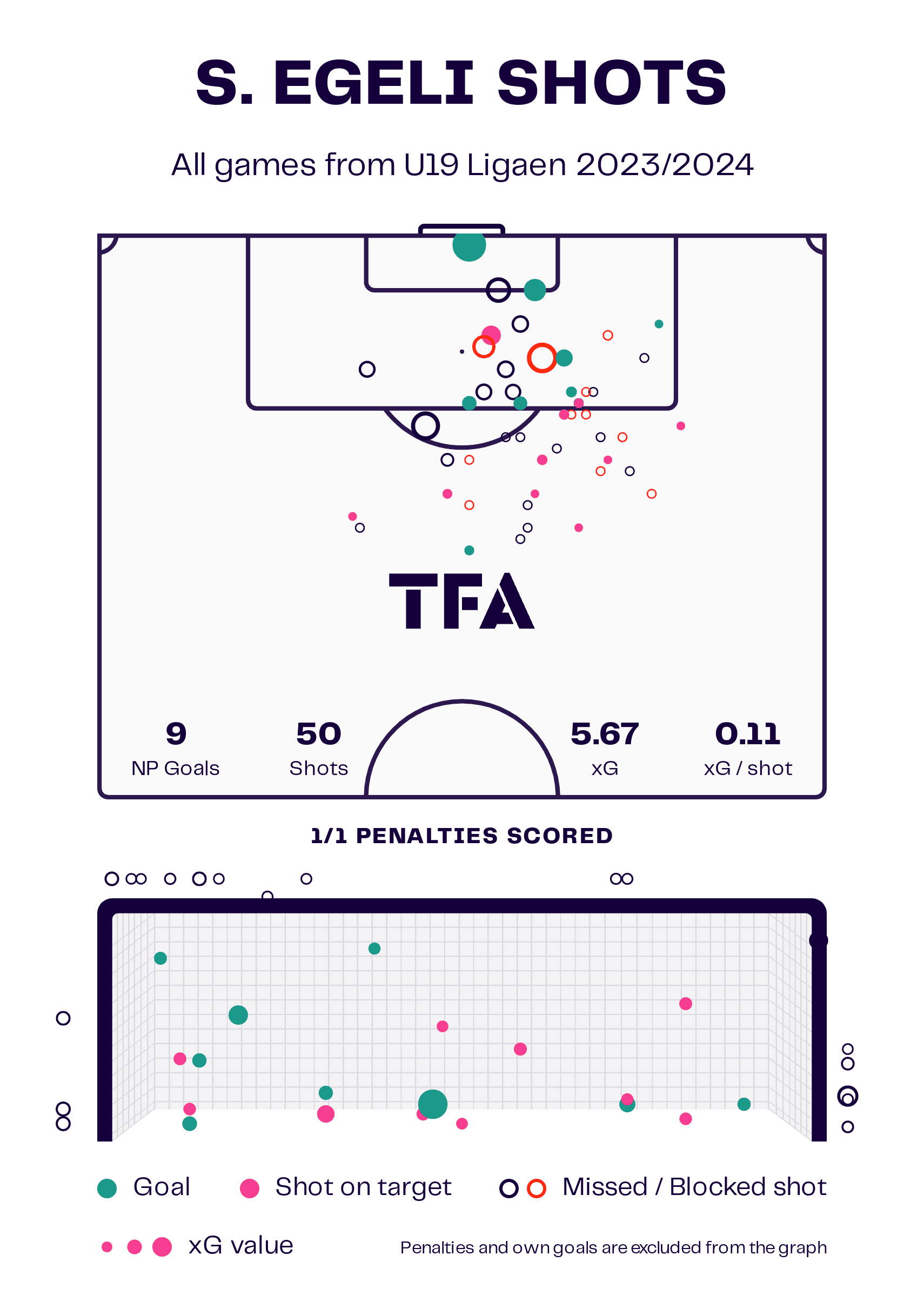
Furthermore, as we mentioned previously, Sindre Walle Egeli has found the back of the net ten times during the 2023/24 season. The data viz shows us that the nine non-penalty goals he has scored have come from an xG of 5.67 suggesting the dynamic attacker is capable of scoring lower percentage opportunities.
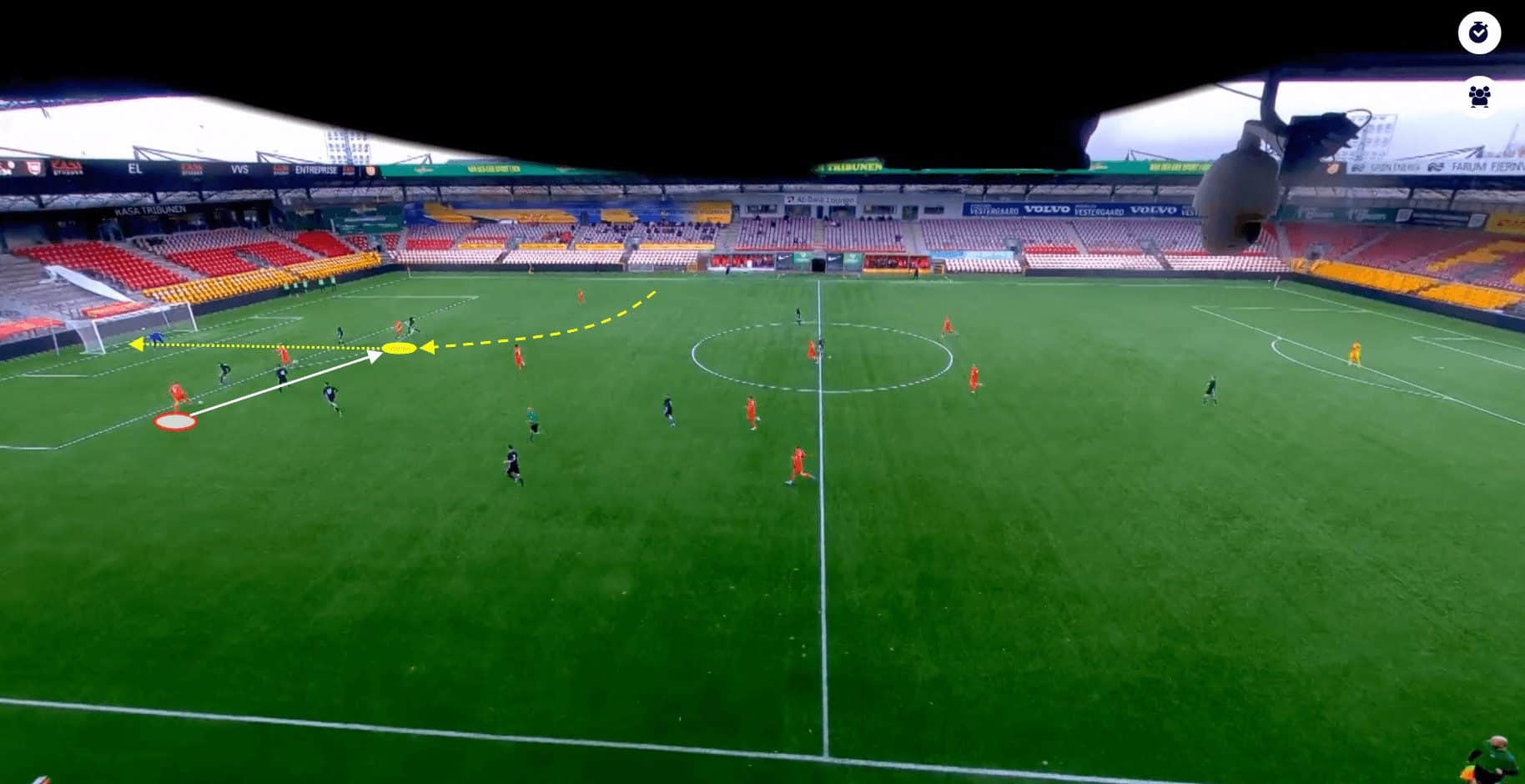
The FC Nordsjælland man averages 6.1 shots per 90, with 3.3 being on target per 90. We can see in this example that as his team are hitting their opponents on the counterattack, he makes one of his favoured runs in from the wing. As the ball is played into his path, he hits a first-time shot into the bottom corner.
Egeli’s attacking prowess means he is very much an inside forward and could play up front, although he would most probably be suited to playing in a front two rather than as a lone striker. The 17-year-old has huge potential to go on and be a key player for FCN sooner rather than later. He is dynamic, aggressive and progressive in his style of play and has already established himself as one of the most talented young players in the FC Nordsjælland youth system. At just 17, the sky is the limit for Sindre Walle Egeli.
Oliver Klang – U17
The next player we are going to look at in this analysis is 16-year-old central midfielder Oliver Klang.
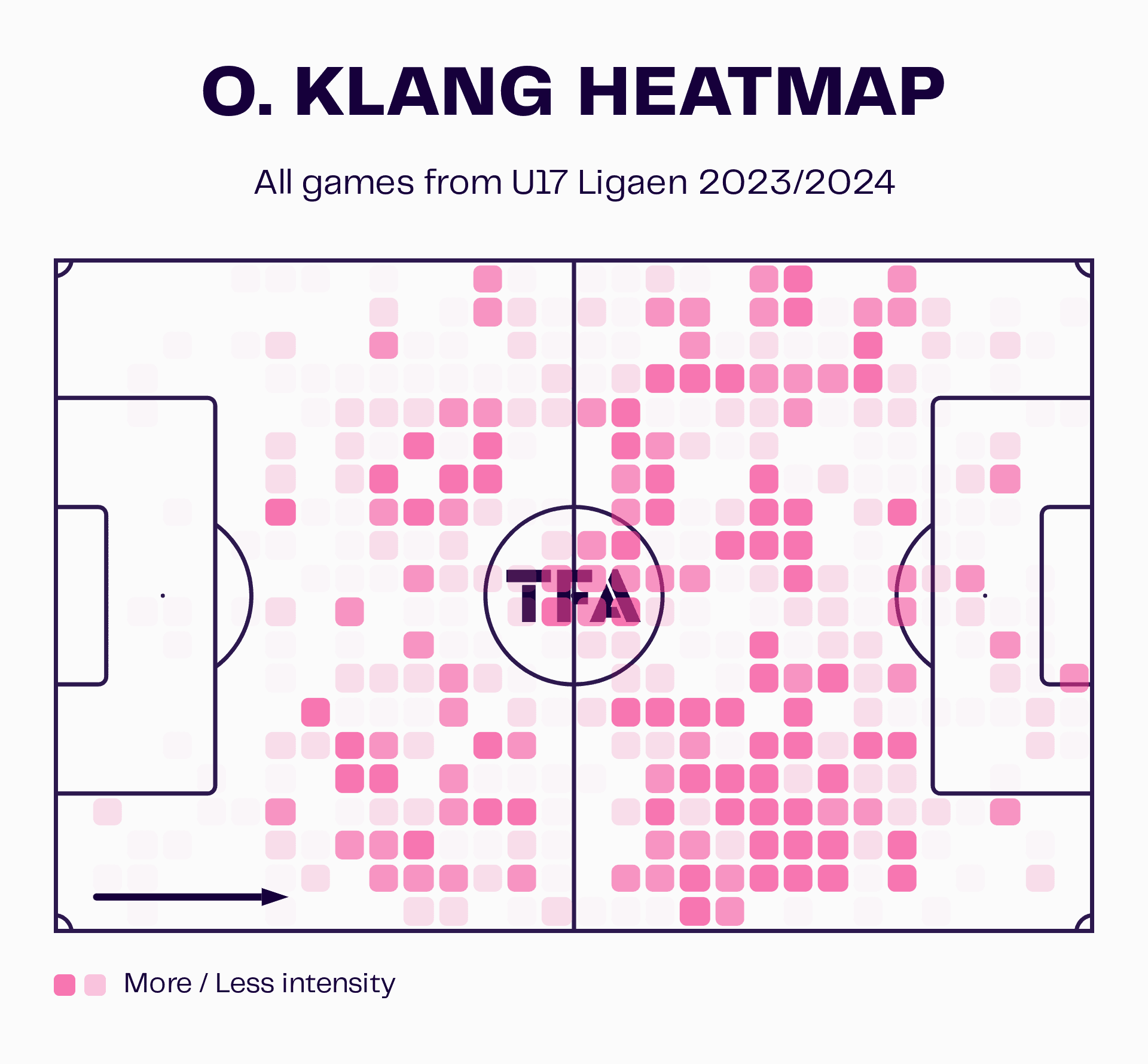
Klang is comfortable playing as either the left or right-sided central midfielder in a 4-3-3 system. We can see from the heat map that he moves out into the half-spaces and wide areas quite frequently. This allows the young central midfielder to stretch the opposition’s defensive structure.
This strategic movement not only provides width to the team’s attack but also forces opponents to adjust their defensive positions. It can create spaces in central areas for other attacking players, such as the wingers, to make inverted runs to exploit spaces, therefore adding depth and unpredictability to the team’s offensive strategies.
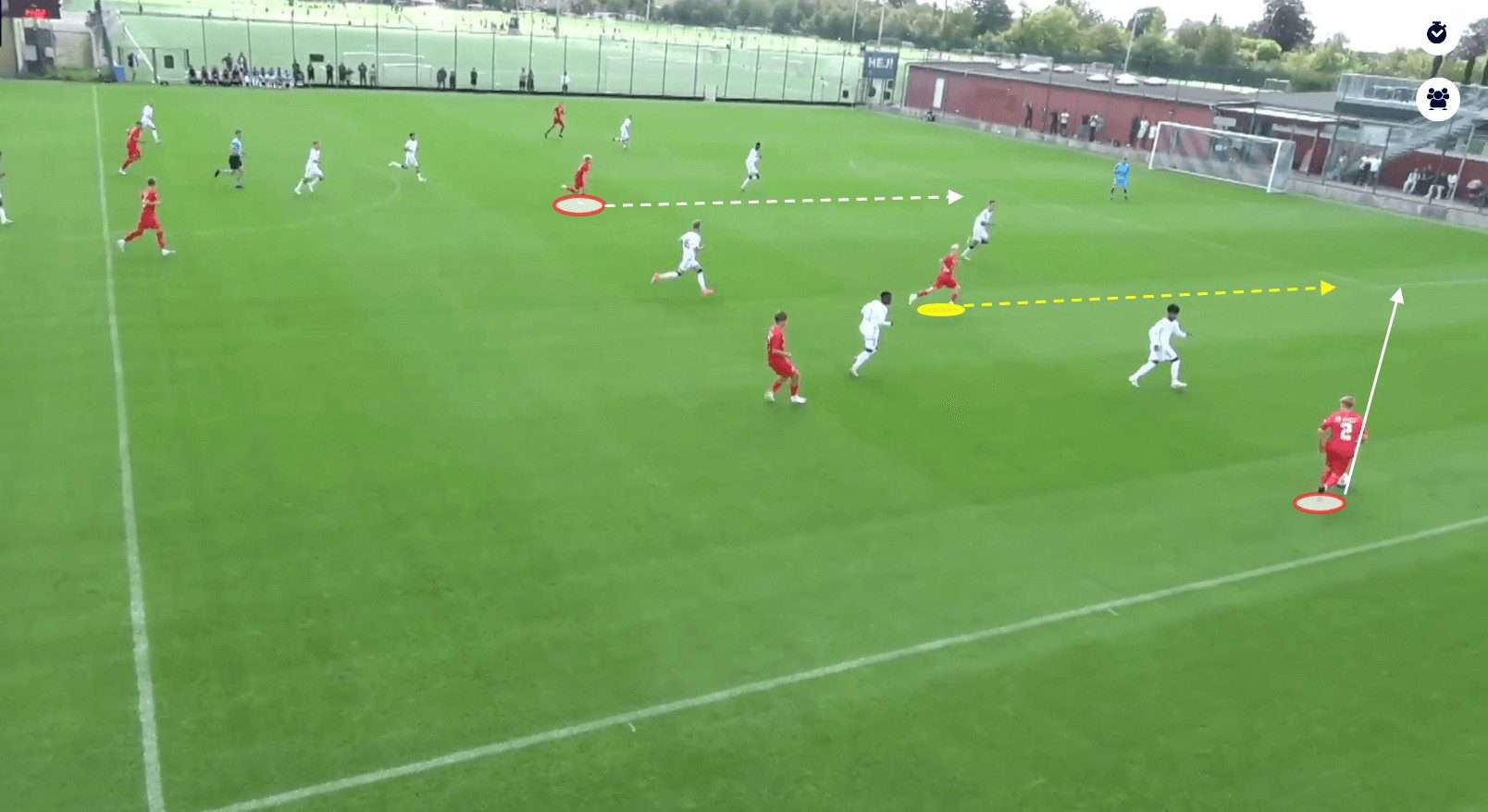
We can see here that Klang enjoys pushing forward and making these runs in behind the opposition’s defensive line, often into the half-space or wide area. This means he can combine with wingers or full-backs, creating situations where the opposition is outnumbered. This superiority allows for effective ball circulation, intricate passing sequences, and the potential to exploit defensive gaps in wide regions.
Furthermore, this also means that Klang can drag defenders out of position to make space in central areas for the centre forward and wingers to make runs into the penalty area. Having midfielders playing in these spaces facilitates positional rotations, which can cause chaos for the opposition’s defence to track, leading to gaps occurring in the defensive structure.
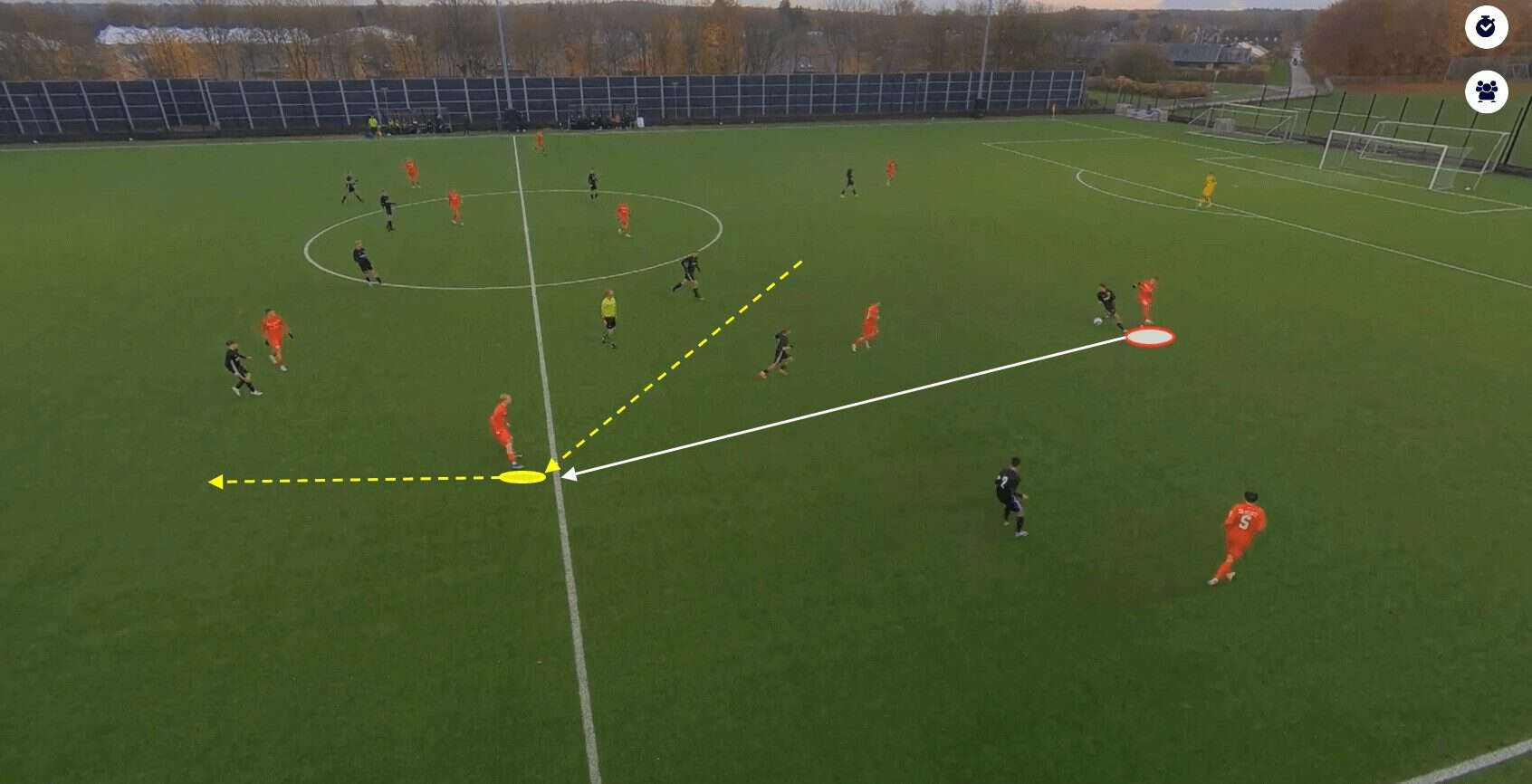
Additionally, operating in the half-spaces requires tactical intelligence, and a midfielder who excels in this area can exploit gaps between opposition defenders and midfielders. As we see above, this strategic positioning allows Klang to receive the ball in dangerous areas, turn quickly, and contribute to intricate attacking combinations or run into open space. It also facilitates the creation of goal-scoring opportunities and supports Nordsjælland U17’s goal-scoring endeavours.
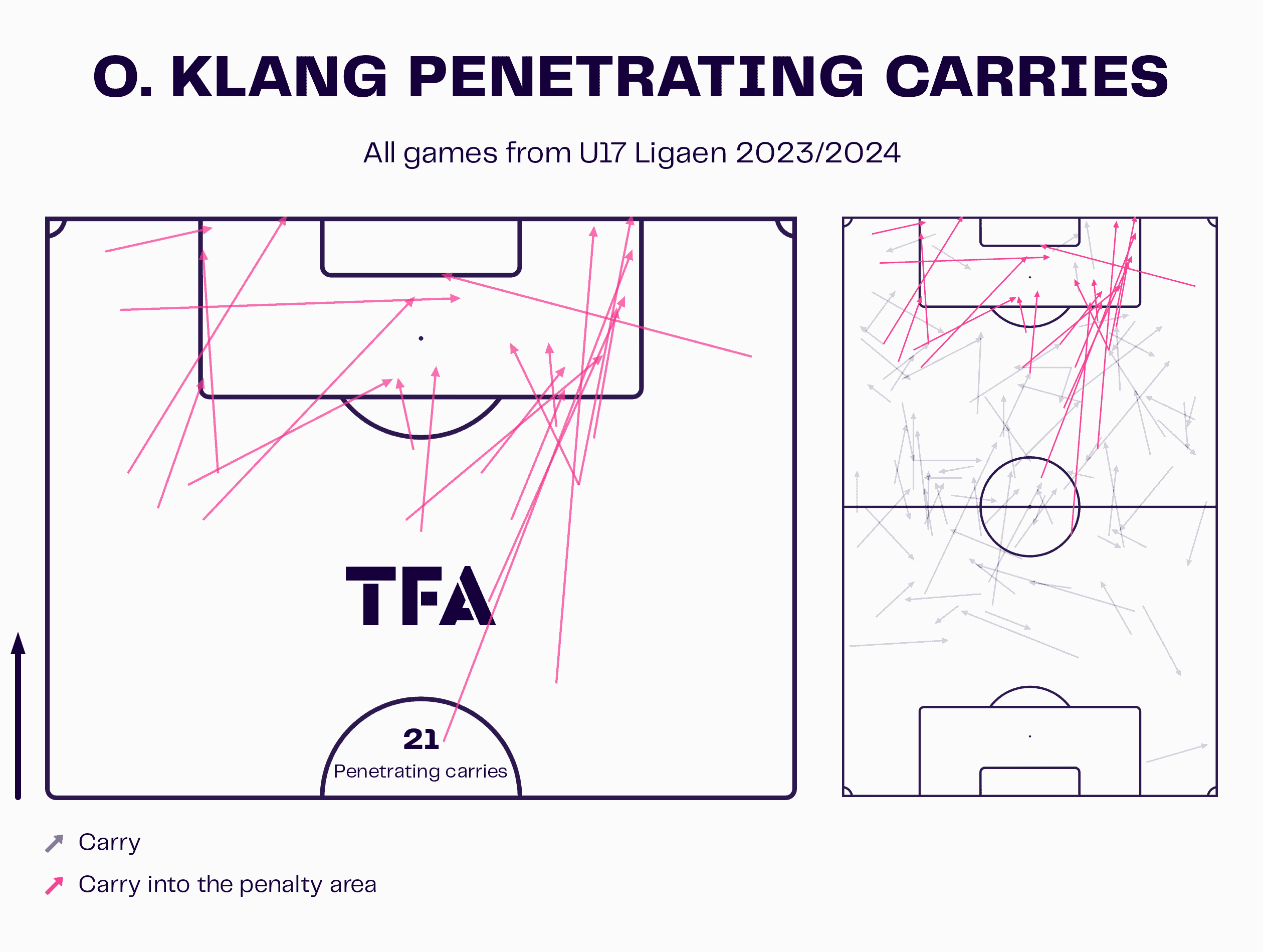
In regards to his ball-carrying abilities, Klang is very direct and likes to run at his opponent in 1v1 situations. He averages 5.68 dribbles per 90 and 2.32 progressive runs per 90. The data visual shows that the 16-year-old has made 21 carries into the penalty area this season.
One of the benefits of this is that as Klang advances with the ball into the penalty area, he forces the opposition’s defensive structure to react. By carrying the ball into the box, he can create openings for teammates by drawing defenders over to him in a bid to dispossess him, or he can create shooting opportunities for himself.
This also contributes to breaking down compact defences. When facing opposition with a deep defensive block, Klang’s forward runs can disrupt the established lines and force defenders to make decisions. The defensive disorganisation is what opens up spaces and can create goal-scoring opportunities for FCN.
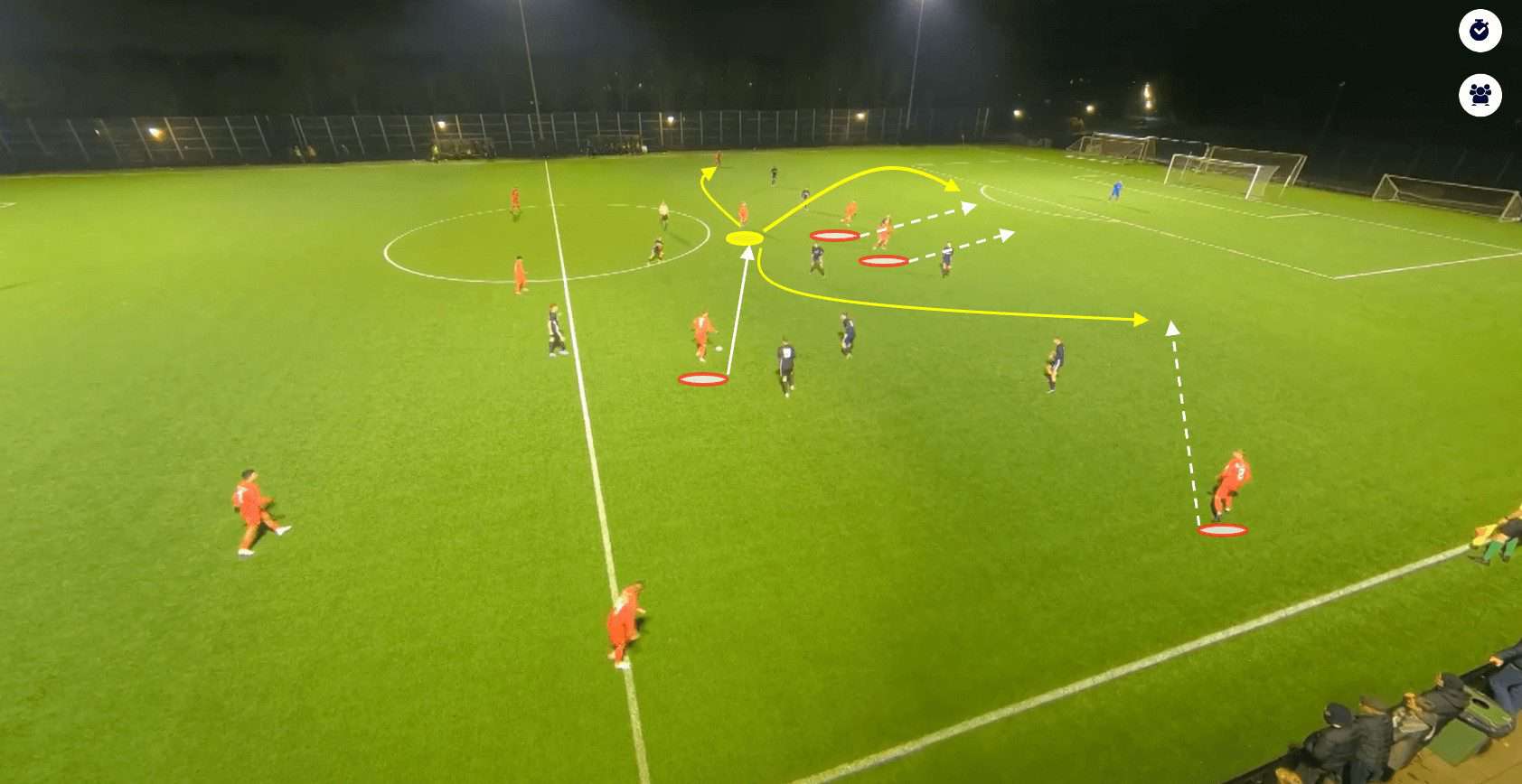
The young midfielder loves to get forward, and as we have established, he thrives when given the opportunity to carry the ball forward. However, Klang does showcase his passing abilities quite frequently. He has the natural ability to hold his position whilst everyone around him is moving, which often means he can receive the ball in acres of space, as we can see in this image.
We can see here that Klang receives the ball and has a multitude of passing options available to him. Although not something he does very often, Klang possesses the ability to dictate the tempo of the match.
He has an excellent passing range and averages an 85% pass accuracy per 90. The Nordsjælland midfielder is comfortable playing long passes, quick round-the-corner passes to link up play or through passes into the path of attackers running in behind.
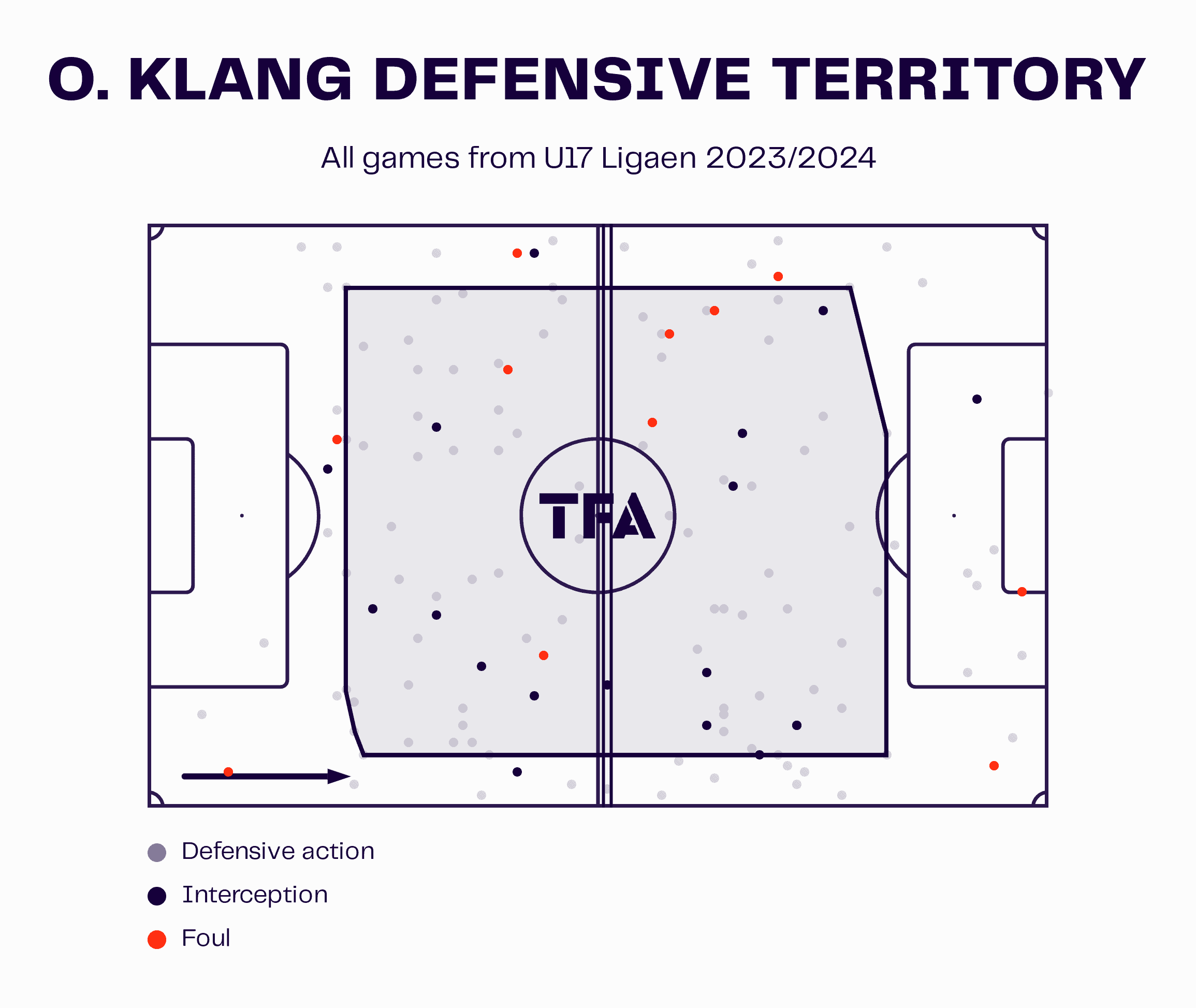
Moreover, Klang does not shy away from his defensive duties. The young midfielder’s capacity to cover extensive ground enhances FCN’s defensive stability. He actively tracks back and looks to disrupt the opposition’s buildup play by making crucial interceptions contributing to regaining possession.
The 16-year-old Swede covers a lot of ground defensively, as we can see from the data visual. Klang typically looks to counterpress instantly after losing possession, and he very often forces the opposition into making errors, leading him to make 7.07 ball recoveries per 90, with 55.7% being in the opposition’s half.
Oliver Klang is perhaps not as first-team-ready as Egeli, but he certainly has all the skills required to break through in the near future. The young midfielder is certainly one to keep an eye out for in the next few years.
Villads Schmidt Nielsen – U19
The third player we are going to look at in this scout report is 19-year-old central defender Villads Schmidt Nielsen. The right-footed defender typically lines up as the left-sided centre-back for Nordsjælland U19s.
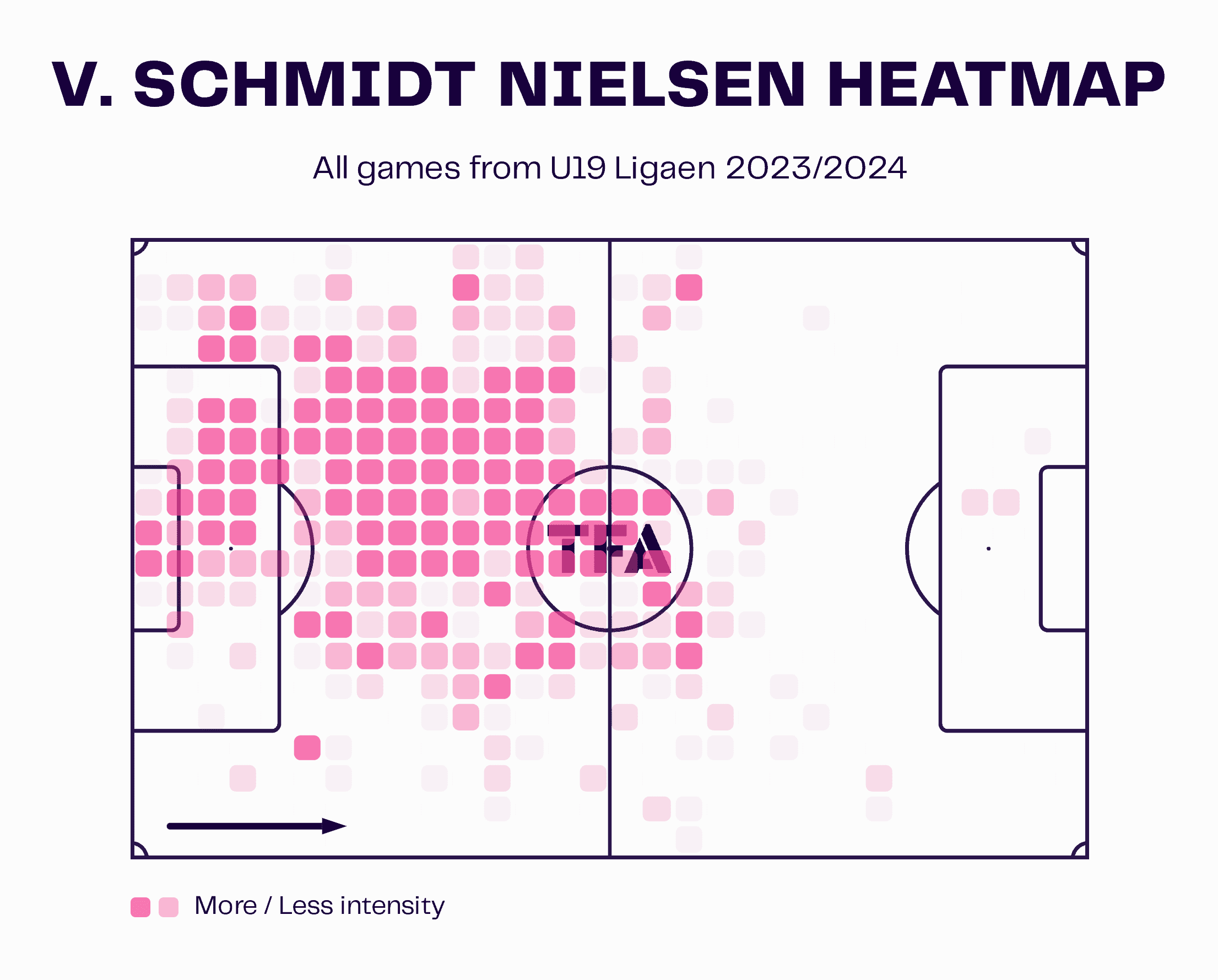
We can see from the heatmap that Nielsen typically pushes up higher and occupies spaces in the opposition half. This is a very clear tactic from Nordsjælland U19s as they seek to pin their opponents back and prevent them from being able to play out. This strategic positioning limits the effectiveness of opposition counterattacks and puts pressure on the opponents to play in areas where Nordsjælland are more likely to regain possession.
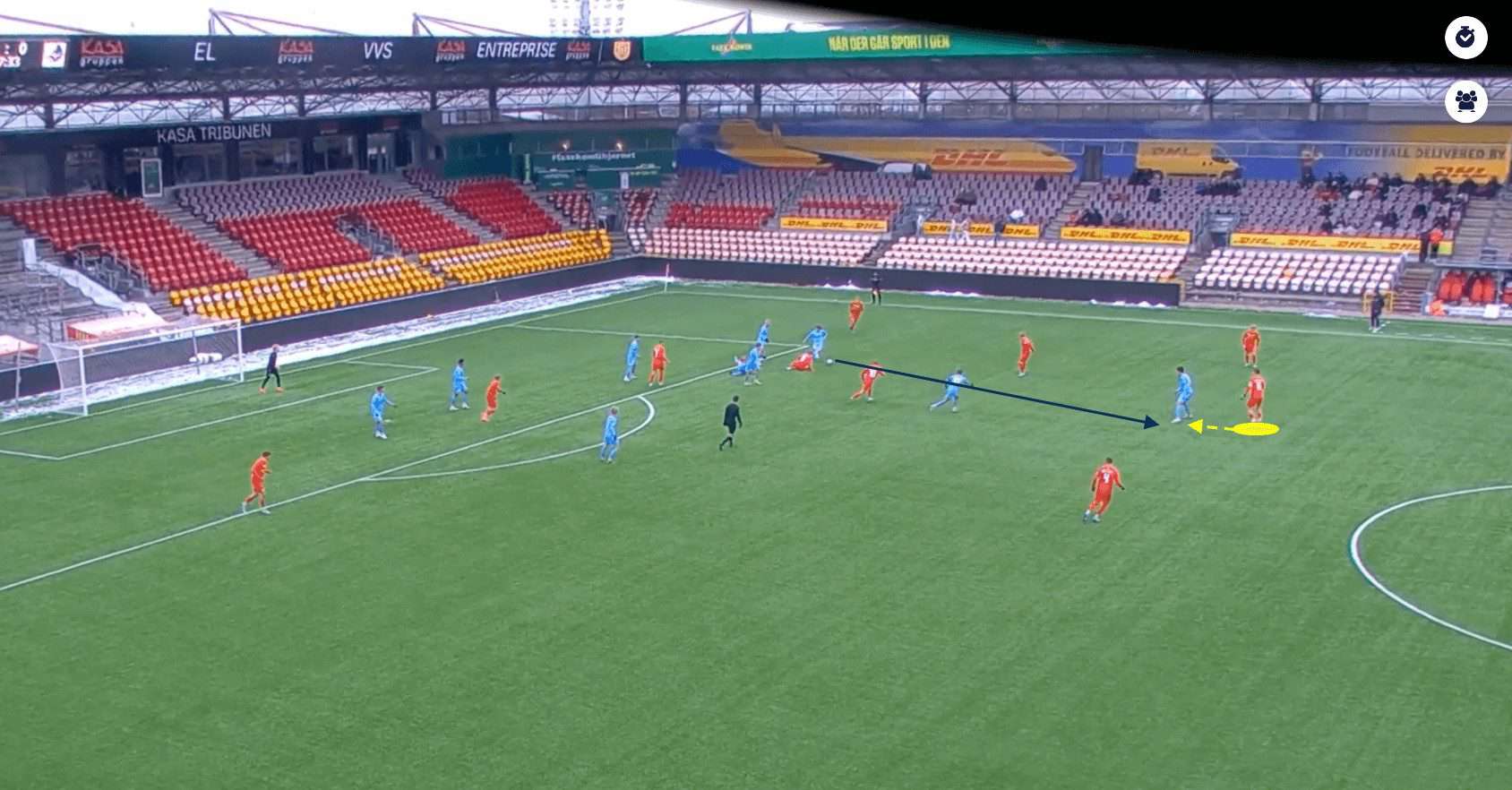
An excellent example of this can be seen here. As the Nordsjælland team turnover possession, Nielsen recognises where the ball is most likely to be played. He puts his opponent under pressure immediately to prevent him from turning when he receives the ball. This means the opposition cannot play out from defence, and Nordjsælland force them backwards.
The 19-year-old is physically strong and uses this to his advantage, standing his ground against opponents in the 12.22 duels that he averages per 90. He knows how to position himself well to ensure that he wins most of the ground duels, which proves to be important for his team and their style of play.
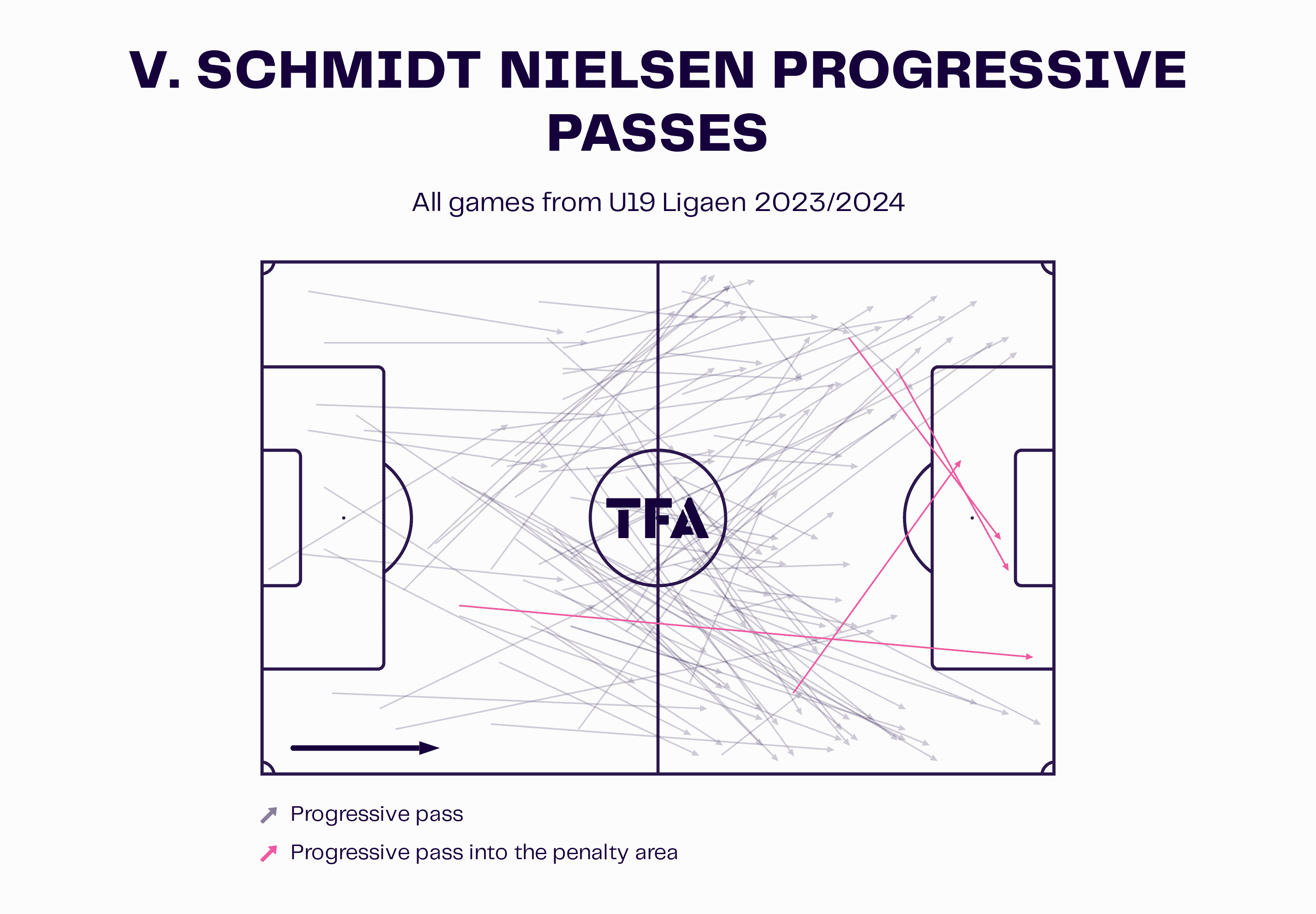
Villads Schmidt Nielsen is the epitome of a modern-day central defender. He is supremely calm on the ball and is very progressive with his passing. The data visual above shows us how he likes playing line-breaking passes to move Nordsjælland U19s up the pitch swiftly.
The centre-back understands how to initiate effective buildup play from the back. He becomes a key link between the defensive and midfield lines by delivering accurate and forward-thinking passes. Progressive passes enable Nordsjælland to transition smoothly from defence to attack, breaking through the opposition’s initial defensive lines and advancing the ball into more attacking areas of the pitch.
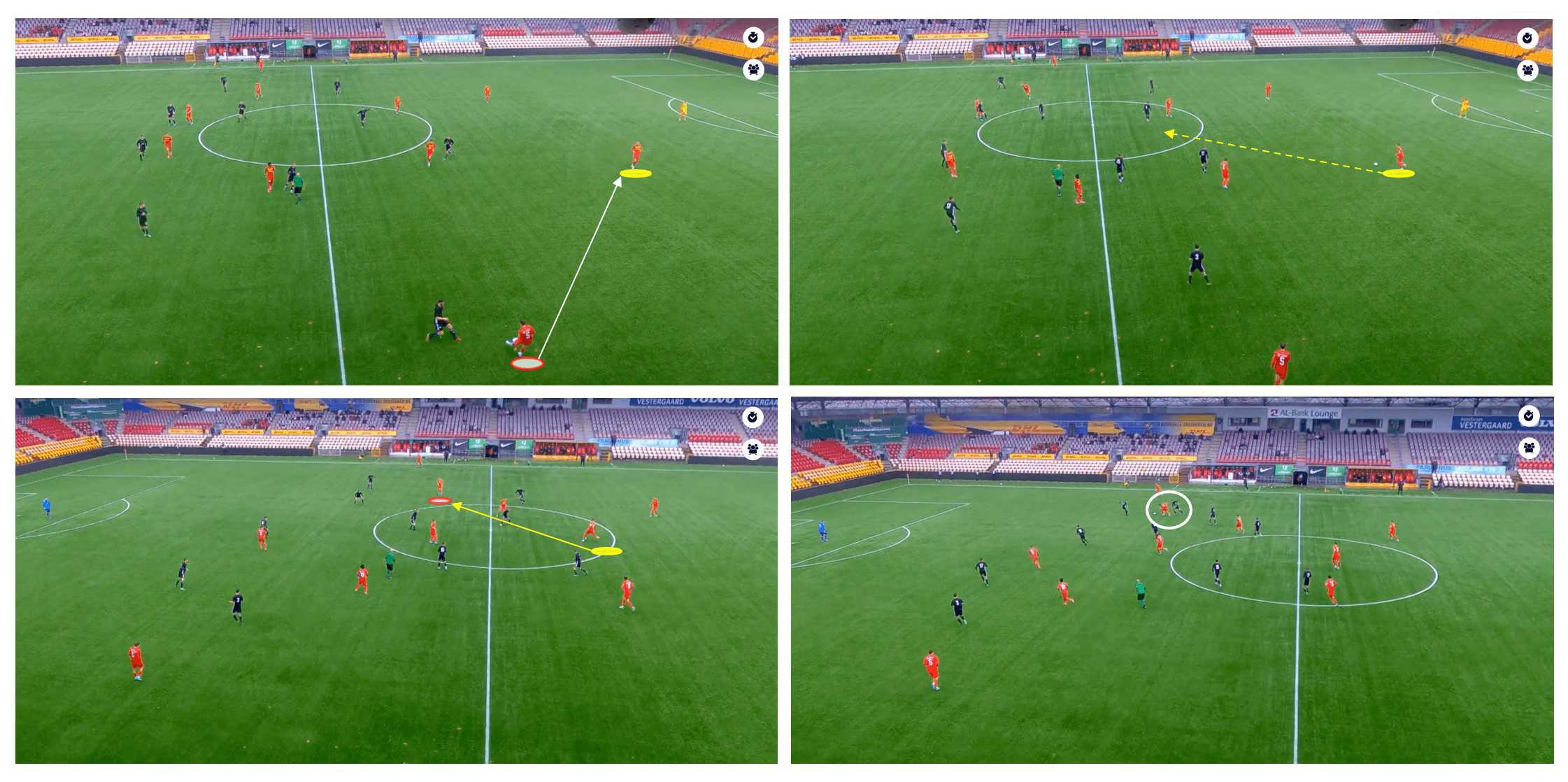
We can see in this example how the young defender carries the ball forward whilst looking for the ideal passing outlet. He then plays a progressive pass into the feet of his teammate, who is able to spin away from his defender and carry the ball forward.
Nielsen’s passing ability allows Nordsjælland to exploit spaces in the opposition’s defensive structure. Having a centre-back who can identify gaps in the opposing formation and deliver precise passes into those areas creates opportunities for attacking players to receive the ball in dangerous positions.
This is also vital for maintaining possession and controlling the game’s tempo. Instead of opting for conservative or lateral passes, progressive passes from Nielsen can dictate the rhythm of the match. By bypassing opponents and finding teammates in advanced positions, he can dictate the pace of play and keep the opposition on the back foot.
Furthermore, Nielsen is usually reliable in possession, averaging 81.45 passes per 90 with an 89.8% pass accuracy rating. He also averages 9.94 passes into the final third per 90, showing just how influential he is for FCN U19s in their attacking play.
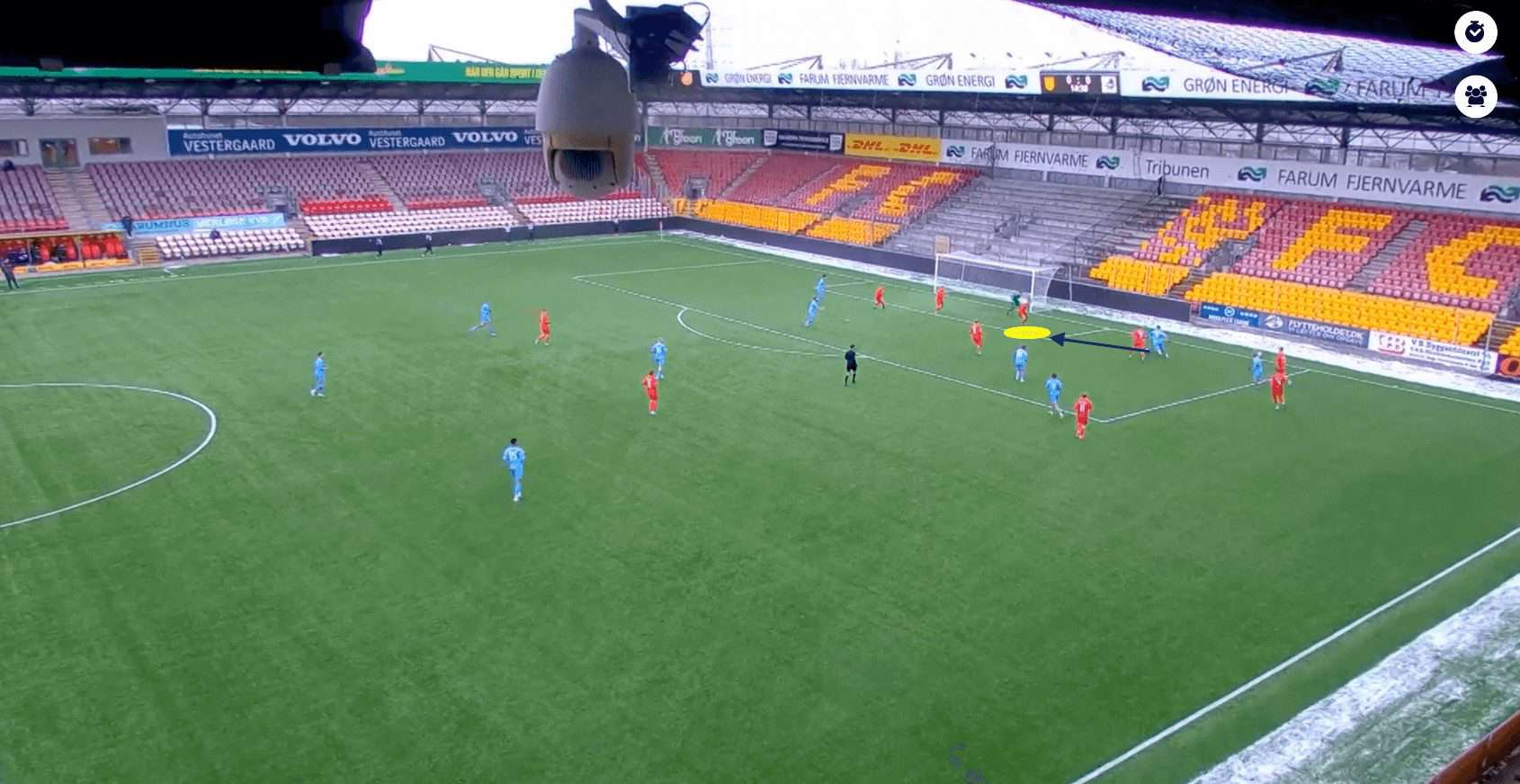
Moreover, the young central defender reads the game very well, so he can appropriately position himself to make important interceptions and clearances. In this instance, Nielsen recognises that the opponent has the speed to bypass his marker and understands that this poses a threat to FC Nordsjælland.
The defender adjusts his positioning to ensure that he is in the right place to intercept the cross and make a clearance. Additionally, his precise positioning allows Neilsen to utilise his body shape when making clearances, ensuring that the clearance is executed with optimal power, accuracy, and direction.
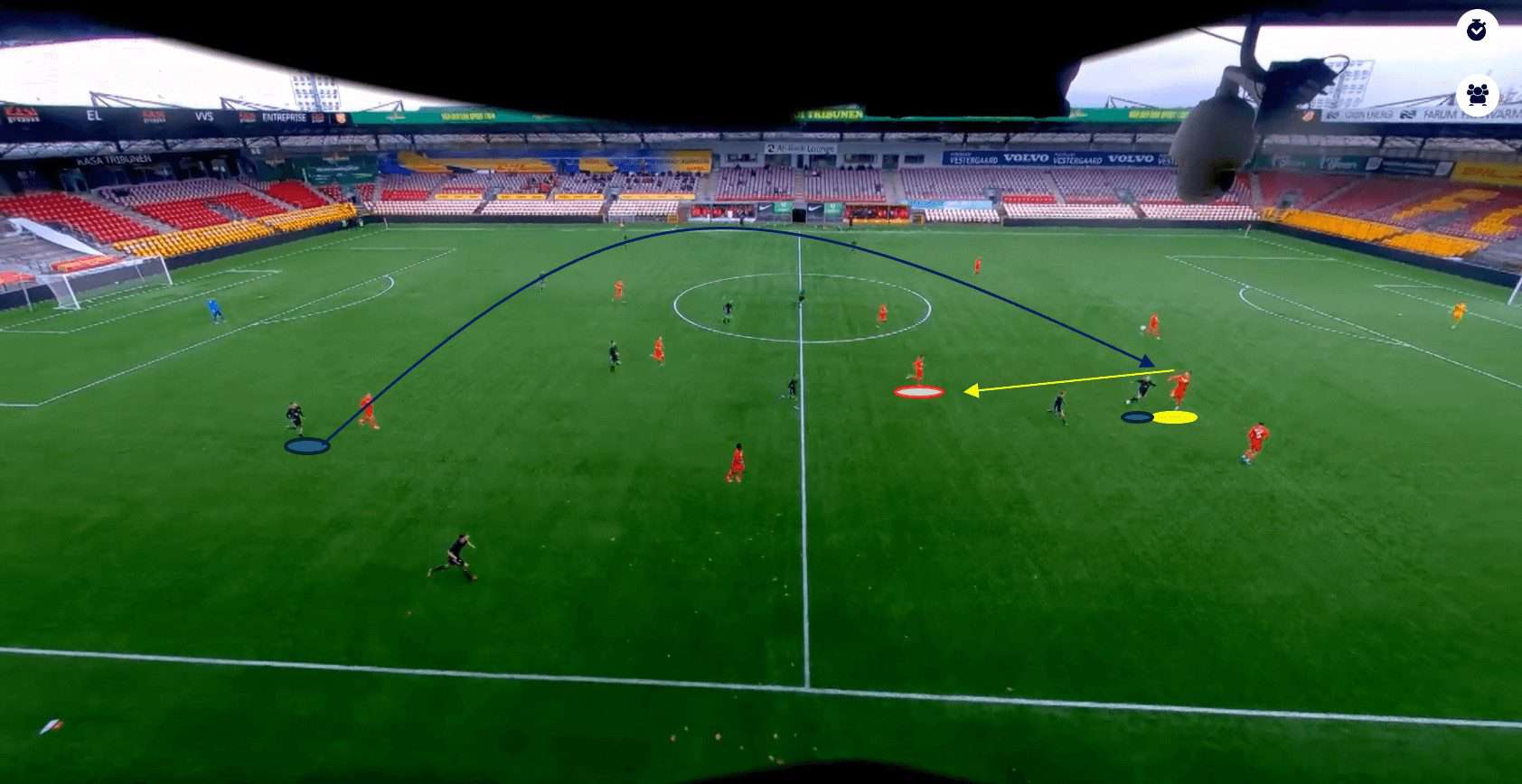
Of course, as a central defender, Nielsen is expected to dominate the aerial battles. He does this well, once again relying on his intelligence and positioning to ensure he makes the right decisions.
Nielsen averages 3.5 aerial duels per 90 and has a success rate of 60.5%. We can see in the example above once he reads that the opposition defender is going to play a long pass; he just takes a step back to give himself space to watch the flight of the ball and ensure his opponent cannot spin him and run in behind. With an excellent jumping reach, he leaps above his opponent and ensures that he heads the ball in the direction of his teammate.
Villads Schmidt Nielsen is a wonderfully talented ball-playing defender and is one to keep an eye out for in the future.
Conclusion
In this scout report, we have highlighted three players within the Nordsjælland youth system we think could break into the first team pretty soon. Sindre Walle Egeli is a hugely talented attacker who will bring some exciting flair and dynamism to the FC Nordsjælland front line.
Meanwhile, Oliver Klang is a standout central midfielder at just 16 years of age, and Villads Schmidt Nielsen appears to be a promising central defender who possesses some excellent in-game intelligence and passing abilities.
The FC Nordsjælland youth system has garnered huge praise for the way it develops players, and it’s not difficult to see why. In this analysis, we have talked about just three players but in truth, there are many talented youngsters in the youth system that could break into the first team soon. The future is certainly very bright at the Right To Dream Park.

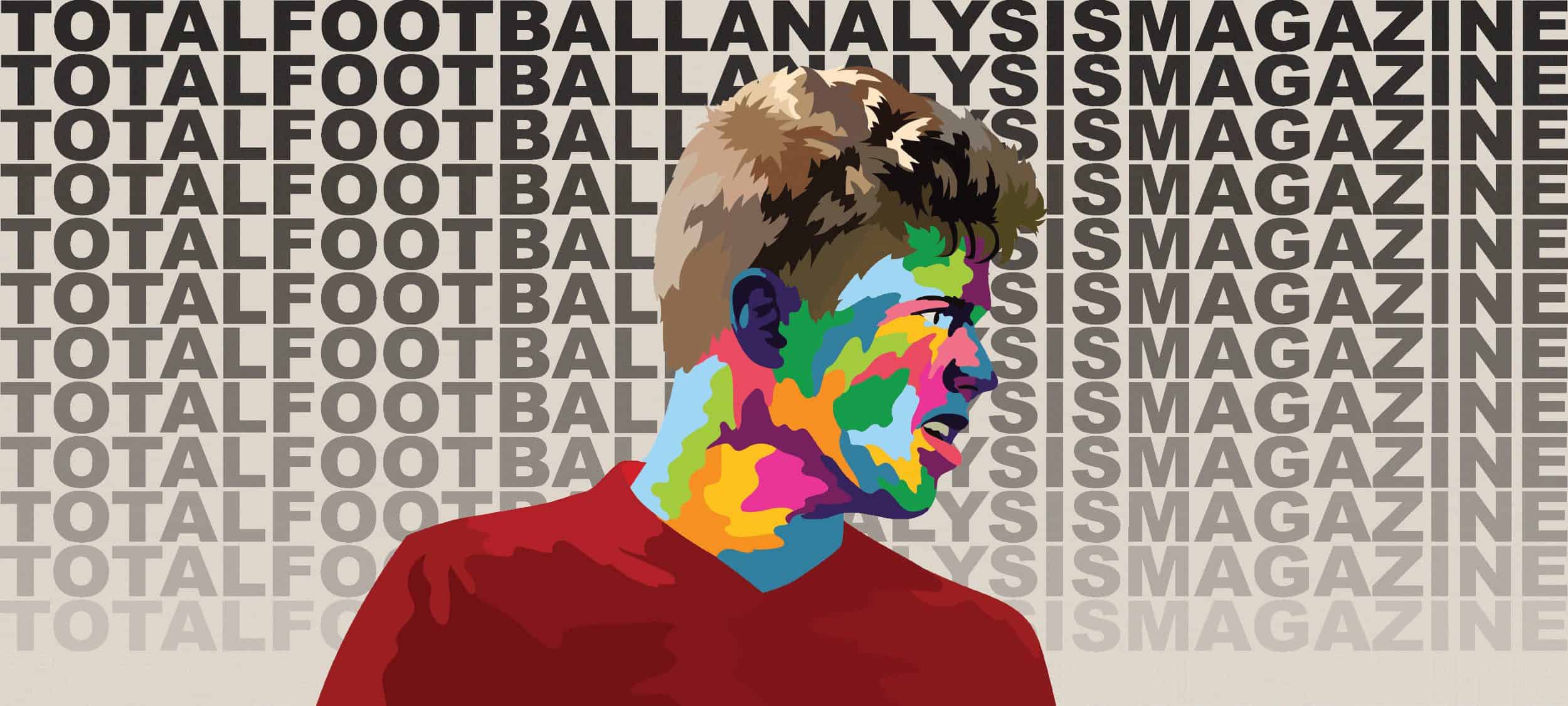



Comments